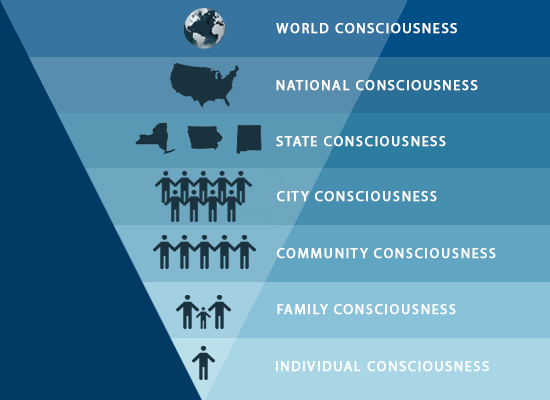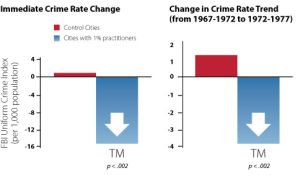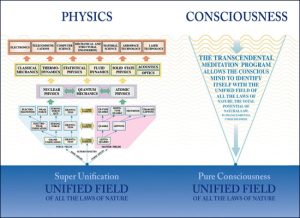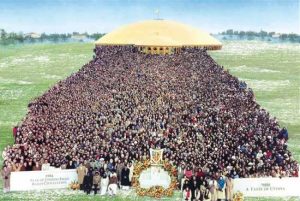As early as 1962, TM Founder Maharishi Mahesh Yogi proposed that just a small percentage of people practicing the Transcendental Meditation technique could eliminate the causes of international conflict. “While 10 percent would be ideal, even if only 1 percent of the world’s population meditated, it would be sufficient to do away with the hatred that causes war,” Maharishi said in a press interview.1
At that time there were no scientific studies verifying the personal benefits of TM practice, much less its benefits for society as a whole. Now, over 60 years later, there are more than 800 published studies confirming the benefits of the TM technique, including peer-reviewed research demonstrating its positive effects on society. This societal phenomenon is known as the Maharishi Effect, because it was predicted by Maharishi Mahesh Yogi.
How could the simple, easy TM technique, practiced by just 1 percent of the population, have beneficial effects on society as a whole? To understand these results, we need to know more about collective consciousness and the field effect of consciousness.
Collective consciousness
Sociology demonstrates that society is a web of interactions between people. Whatever we think, feel, speak, and convey through our actions is transmitted to everyone around us—our family, friends, co‑workers, and even strangers.

The World Wide Web connects us through technology
Now we’re also connected electronically with the entire globe through the Internet, further expanding the reach of our social interactions.
Maharishi went further by highlighting an even deeper principle at the level of consciousness itself.
He explained that society has layers of collective consciousness—family consciousness, community consciousness, city consciousness, state consciousness, and national consciousness—through which we all directly and indirectly influence each other, positively or negatively.

The layers of consciousness
Collective consciousness is the sum total of all the individuals that make up a society. Stressed individuals create a stressed collective consciousness, Maharishi said, and that stress influences everyone else in society and is the root cause of social problems.2,3 A highly stressed collective consciousness is at risk of erupting into violence. Sociological research shows that higher rates of individual stress—such as bankruptcies, unemployment, divorces, and high-school drop-out rates—correlate with higher levels of crime, sickness, and other measures of lack of well-being in society as a whole.4
It is now widely accepted that the TM technique relieves individual stress, as shown by hundreds of scientific studies. What is less well known is that research has also demonstrated that the practice of the TM technique by even 1 percent of a population reduces social stress, as documented by reduced violent crime, fewer psychiatric crisis calls, and decreases in other measures of acute social stress.
When our brains are stressed and functioning incoherently, our thinking is not as clear and our higher, executive functions may shut down. But when individuals become calmer and less stressed, society also becomes more coherent, and we are all better protected from disruptive influences.
While it’s true that the TM program has been shown to be very effective for individuals in offender rehabilitation programs5, the broader societal effects of TM are due to the principle of collective consciousness, the overall social atmosphere that arises from the cumulative thought and behavior of all members of a community or society.
Why 1 percent?
The sources for this figure are both ancient and modern. Maharishi explained that according to the Vedic tradition of India, direct experience of the field of infinite silence through the TM technique creates waves of orderliness that radiate out into the environment. “In the vicinity of yoga (the unified state of consciousness), hostile tendencies disappear,” say the Yoga Sutras, compiled over 2,000 years ago by the venerated sage Patanjali.6 Here, yoga means the unified state of Transcendental Consciousness.
Maharishi had also been trained in physics, and knew that the coherent action of 1 percent of a system can organize a whole system into greater coherence. For example, 1 percent of the cells in the heart, the pacemaker cells, organize the rhythmic beating of the heart. Similarly, approximately 1 percent of the neurons in the brain working together lead the brain into a state of global coherence. This synchronous activity in turn organizes neuronal processes to work together for fine-motor behavior, memory, intelligence, creativity, and even moral reasoning.7-13
Science validates the positive effects of TM on society
The beauty of the Maharishi Effect is that by defusing collective stress, it reduces the root causes of conflict in the surrounding population.
In the early 1970s, when a group of sociological researchers learned of Maharishi’s hypothesis that 1 percent of a population practicing the TM technique would reduce violence and increase peace, they conducted a controlled study examining FBI crime statistics in 24 U.S. cities. In 12 of the cities, 1 percent of the population had learned the TM technique; the other 12 were control cities with far fewer meditators.14
At that time violent crime was rising across the United States, but when the threshold of 1 percent practicing the TM technique was reached in each of the 12 TM cities, the crime rate began to drop and continued to decrease significantly, while in the 12 control cities crime continued to rise.

Reference: M. C. Dillbeck, Landrith III G., Orme-Johnson D. W. “The Transcendental Meditation Program and Crime Rate Changes in a Sample of Forty-Eight Cities.” Journal of Crime and Justice 4 (1981): 25-45.
Scientists conducted more studies, which consistently showed that 1 percent of a population practicing the TM technique resulted in measurable reductions in crime and violence as well as improvements in the quality of life. The double chart shows the results of a study comparing 24 cities with 1 percent of the population practicing TM and 24 cities with less than 1 percent of TM practitioners over an 11-year period (1967–1977).
The left-hand chart shows there was an immediate decrease in the crime rate in the 1 percent cities the year 1 percent was reached, compared to a slight increase in the control cites. The right-hand chart shows that there was a trend of decreasing crime rate over the 7 years after the 1 percent cities reached 1 percent compared to a trend of increasing crime in the control cities.15
For an in-depth discussion of this research, see Dr. David Orme-Johnson’s article “Can My TM Practice Help Create a More Peaceful World?”
Since these improvements were not due to the criminals themselves learning TM, what is the mechanism at work here?
The field effect of consciousness
Neuroscience shows that the brain becomes highly coherent during TM practice. “The orderliness of brain functioning in the individual spills over into society,” says Harvard-trained quantum physicist Dr. John Hagelin, who is the President of Maharishi International University.

Dr. Hagelin identifies human consciousness at its deepest level as an all-pervasive, fundamental field (for a larger version of this chart, visit the Unified Field page)
Drawing upon quantum field theory, Dr. Hagelin explains how we can understand collective consciousness in terms of the unified field. “What we’ve discovered at the foundation of the universe is a universal field where all the forces and particles of nature are united as one. They are ripples on a single ocean of existence,” he says in a Huffington Post interview. “Our minds profoundly mirror the hierarchical structure of nature. We can dive within to deeper levels of mind, accessing more powerful levels of thought, and ultimately, the unified field itself, the most powerful, limitless, universal level of our own consciousness.”
Dr. Hagelin explains that the non-material unified field is the deepest, most fundamental level of everything—including ourselves. This accounts for how transcending can create a positive influence on the environment. When we contact this underlying, universal field of harmony during our TM practice, we enliven it. Since it is a nonlocalized field existing everywhere, when we enliven it within ourselves, we enliven it everywhere, within everyone and everything.
The Maharishi Effect, where a positive influence is created in the environment when 1 percent of a population transcends regularly, is a clear demonstration of the field effect of consciousness. “Since the unified field is an all-pervading field, when unity is enlivened in the individual, unity is enlivened everywhere. This is a field effect of consciousness,” Dr. Hagelin says.
National and global demonstrations of the Maharishi Effect
Maharishi later predicted that these same powerful coherence-creating results would occur if an even smaller percentage—the square root of 1 percent—practiced the advanced TM-Sidhi® program together in large groups. Subsequent scientific research has repeatedly confirmed Maharishi’s prediction of this group phenomenon, named the Super-Radiance Effect.
The Maharishi Effect and the Super-Radiance Effect have been confirmed by over 50 demonstrations and 24 scientific studies. One such study—from Yale University’s Journal of Conflict Resolution—tracked day-to-day war deaths in Lebanon during a two-month TM assembly in Israel in 1983. On days when the number of TM participants was higher, war deaths dropped as much as 76 percent, and Israel’s quality of life indicators—such as crime, traffic accidents, and fires—rose and fell correspondingly as the number of assembly participants rose and fell. For more about this and other studies, visit the World Peace page.

In December 1983, over 8,000 participants assembled at MIU to demonstrate the Maharishi Effect.
To test the Maharishi Effect on a global scale, a team of scientists monitored a research project in 1983, when the square root of 1 percent of the world population was about 7,000. To test whether this number of participants could positively influence world events, over 8,000 meditators from 50 countries gathered at Maharishi International University (MIU) in Fairfield, Iowa, in December 1983, to practice the TM-Sidhi program together for two weeks.
The scientists found that the assembly correlated with sudden and significant improvements in international relations and the global economy, along with a dramatic decrease in war and violence in troubled areas around the world. International conflicts decreased by approximately 30 percent, and international terrorism decreased by 72 percent.16
In 2006, over 1,000 volunteers from the United States and around the world gathered again in Fairfield, Iowa, for another ambitious experiment, this time to help our nation. Their endeavor, called the “Invincible America Assembly,” would be the largest long-term test of the Maharishi Effect on national trends. Based on previous research into the societal effects of the TM and TM-Sidhi programs, scientists predicted significant decreases in U.S. crime, improvements in the economy, and a rise in positive quality of life indicators.
Previous research had confirmed that when the size of a TM-Sidhi group surpasses the square root of 1 percent of a population—about 1,750 for the United States at that time—measurable, positive shifts in social trends can be observed. As soon as the Assembly began, statistically significant changes in national trends began to appear: The U.S. crime rate, which had been rising steadily for years, leveled out and began to fall.17, 18
By May 2008, the number of Assembly participants began to exceed the requisite threshold every day, with over 2,000 participants in place by June and throughout that summer. Scientists monitored crime rate and other social indicators, tracking possible correlations between the number of meditators and societal trends. Research repeatedly confirmed the effects, with the FBI Uniform Crime Index showing a dramatic decline in violent crime rates and murder rates in major U.S. cities dropping to their lowest levels in over 40 years. 17, 18
Your personal contribution to collective consciousness

Enjoy group meditations at your local TM Center
You can participate in creating the Maharishi Effect simply by practicing the TM technique twice a day. We also invite you to enjoy group meditation at your local TM Center whenever possible, or online group meditations with TM Connect.
To help create an even more powerful effect for yourself and society, consider learning the advanced TM-Sidhi program. Courses are offered regularly throughout the United States and around the world.
Most people practice the TM technique and its advanced programs for their own personal benefit, but it is satisfying to know that in addition to your personal growth you’re also contributing to rising harmony and positivity for the collective consciousness of your family, community, nation, and the world.
To get a taste of what it’s like to be part of a larger community of meditators, visit the TM community in Fairfield, Iowa.
Notes
- Maharishi Mahesh Yogi, quoted in Innsbruck, Austria, newspaper, Tiroler Tageszeitung, 23 July 1962. Quoted in V. Katz. Conversations with Maharishi: Maharishi Mahesh Yogi Speaks about the Full Development of Human Consciousness. Vol. 1. Fairfield, Iowa, USA: Maharishi University of Management Press, 2011.
- J. Forem. Transcendental Meditation: The essential teachings of Maharishi Mahesh Yogi. New York, NY: Hay House, Inc., 2012.
- Maharishi Mahesh Yogi. Creating an Ideal Society. West Germany: Maharishi European Research University Press, 1977.
- A. S. Linsky, Strauss M. A. Social stress in the United Sates: Links to regional patterns of crime and illness. Dover, MA: Auburn House, 1986.
- C. N. Alexander, Walton K. G., Orme-Johnson D. W., Goodman R. S. “Transcendental Meditation in Criminal Rehabilitation and Crime Prevention.” Journal of Offender Rehabilitation 36, no. 1/2/3/4 (2003): 1-383.
- T. Egenes. Verse 2.35. Maharishi Patanjali Yoga Sutra. 1st ed. Fairfield, IA: 1st World Publishing (2010).
- M. C. Dillbeck, Vesely S. A. “Participation in the Transcendental Meditation program and frontal EEG coherence during concept learning.” International Journal of Neuroscience 14 (1986): 147-151.
- S. I. Nidich, Ryncarz R. A., Abrams A. I., et al. “Kohlbergian moral perspective responses, EEG coherence, and the Transcendental Meditation and TM-Sidhi program ” Journal of Moral Education 12, no. 3 (1983): 166-173.
- D. W. Orme-Johnson, Haynes C. T. “EEG phase coherence, pure consciousness, creativity and TM-Sidhi experiences.” International Journal of Neuroscience</em >13 (1981): 211-217.
- S. Palva, Palva J. M. “New vistas for alpha-frequency band oscillations.” Trends in Neurosciences 30, no. 4 (2007): 150-158.
- P. Sauseng, Klimesch W., Schabus M., Doppelmayr M. “Fronto-parietal coherence in theta and upper alpha reflect central executive functions of working memory.” International Journal of Psychophysiology 57 (2005): 97–103.
- R. W. Thatcher. “Coherence, Phase Differences, Phase Shift, and Phase Lock in EEG/ERP Analyses.” Developmental Neuropsychology 37,no. 6 (2012): 476-496.
- F. T. Travis, Arenander A. “Cross-sectional and longitudinal study of effects of Transcendental Meditation practice on interhemispheric frontal asymmetry and frontal coherence.” International Journal of Neuroscience 116, no. 12 (2006): 1519-1538.
- C. L. Borland, Landrith III G. “Improved quality of life through the Transcendental Meditation program: Decreased crime rate.” In Scientific Research on the Transcendental Meditation Program: Collected Papers, Vol. 1, edited by Orme-Johnson D. W., Farrow J. T., 651-658. Livingston Manor, NY: Maharishi European Research University Press, 1977.
- M. C. Dillbeck, Landrith III G., Orme-Johnson D. W. “The Transcendental Meditation Program and Crime Rate Changes in a Sample of Forty-Eight Cities.” Journal of Crime and Justice, 4 (1981): 25-45.
- D. W. Orme-Johnson, Dillbeck, M. C., Alexander, C. N. , Chandler, H. M., Cranson, R. W. “Effects of Large Assemblies of Participants in the Transcendental Meditation and TM-Sidhi Program on Political Crime: Decreased International Conflict and Terrorism.” Journal of Offender Rehabilitation, 36 (2003): 283-302.
- K. L. Cavanaugh, Dillbeck M.C. “The contribution of proposed field effects of consciousness to the prevention of U.S. accidental fatalities: Theory and empirical tests.” Journal of Consciousness Studies, 24(1-2), 53–86.
- K. L. Cavanaugh, Dillbeck M.C. “Field effects of consciousness and reduction in U.S. urban murder rates: Evaluation of a prospective quasi-experiment.” Journal of Health and Environmental Research, 3(3-1), 32-43.




RELATED TOPICS
Consciousness is All There Is
Our consciousness is the basis for everything that we think, do and experience in life.
Invincible America Assembly
The “Invincible America Assembly,” is based on the ancient yogic tradition of maintaining large group meditations to neutralize negative societal trends.
The Power of Collective Transcending
John Hagelin, Ph.D., a renowned quantum physicist, President of MIU, and leading proponent of peace, presents a nonviolent approach to reducing conflict.
My TM
Online Group Meditation
Three ways to meditate at the same time as others in the U.S. and around the world.